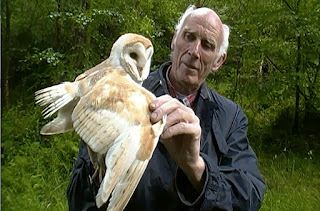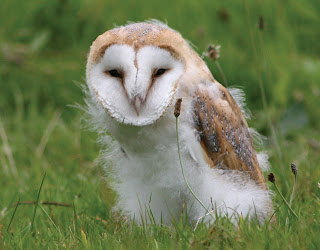A 're-trap' is when a bird is already ringed, then once again trapped and released, sometimes at the same site, sometimes elsewhere. In the past six years, with an ever-growing number of Barn Owls being ringed throughout Ireland, the number of re-traps has also risen. They can give an extraordinary insight into a Barn Owls life, its movements and lifespan, and demonstrate the valuable information that can be learned from ringing birds.
When John Lusby inspected this site in Duhallow on Friday last, he found a Barn Owl in the chimney of the disused house.
(You can click on any of the photos for a closer view)
John Lusby inspecting the chimney at a site in Duhallow (under licence). Barn Owls had bred here in 2010, but were absent in 2011 (M.O'Clery).
To his surprise, it was an adult bird and already ringed. From his database, he discovered the bird was a female and had been ringed as an adult near Ballyferriter on the Dingle Peninsula last summer, 80 km to the west. Then, she had been trapped and ringed by John, along with the male and her four young, at their nest in a nest box. She was at the time one year old, so now would be two.
A two year-old female Barn Owl, originally ringed near Ballyferriter (M.O'Clery).
The ring on her right leg bearing her unique identifying serial number (M.O'Clery).
The nest box at Ballyferriter was predated in the past three weeks, the chicks most likely taken by a Pine Marten, so this raises the question, did she leave her nest in Ballyferriter after the young were taken? Or has she been in Duhallow for a while, and the Ballyferriter site taken over by another female? When examined by John, she had a brood patch on her stomach (an area of bare skin for transferring body warmth onto her eggs) and was, at 480 grammes, very heavy for an adult bird. It is possible she was full of eggs and about to lay at the Duhallow site.
She was returned safely to the chimney, leaving us puzzling how little we know about the movements and habits of Barn Owls in Duhallow, but grateful for this small but detailed insight into this wandering female's life. We will check back at this site to see what happens.



















































